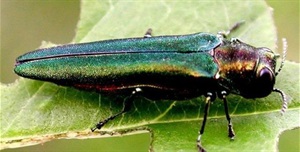 The emerald ash borer (EAB) is a metallic green beetle that bores into ash trees eating the tissues beneath the bark, eventually killing the tree. This non-native insect was first found in the United States near Detroit, Michigan in 2002.
The emerald ash borer (EAB) is a metallic green beetle that bores into ash trees eating the tissues beneath the bark, eventually killing the tree. This non-native insect was first found in the United States near Detroit, Michigan in 2002.
The EAB is now found in 30 states and in 25 counties in North Carolina, including Mecklenburg County. Hundreds of millions of trees have been killed by the EAB across the country. The insect was detected in Charlotte in May of 2017. Report possible sighting of EAB to 800-206-9333 or newpest@ncagr.gov.
Emerald Ash Borer FAQs
What types of trees does the EAB attack? All species of ash trees are susceptible. This includes all four species native to North Carolina - white ash, green ash, Carolina ash, and pumpkin ash.
How does the EAB harm the ash tree? The larvae of the beetle bore into the bark and feed on the tissues of the tree. This prevents the movement of nutrients and water within the tree, eventually causing it to die.
What are the signs of an EAB infestation? The adult leaves a “D”-shaped exit hole in the bark about 1/8 inch in diameter when it exits the tree. The canopy of the tree begins to thin, and dieback begins at the top of the tree. Most of the canopy will be dead within two to five years of when symptoms are first observed.
What can I do to save my ash trees? Insecticides are available for those wishing to protect high-value ornamental trees. Re-treatment must take place every one to two years. Contact a certified arborist for more information on treatment options. Also, consult this Emerald Ash Borer insecticide guide.
How many street trees in Charlotte are ash trees? It is estimated that the City manages 1,300 ash trees in the public right of way.
Where can I get more information? Consult these links for more information about EAB.